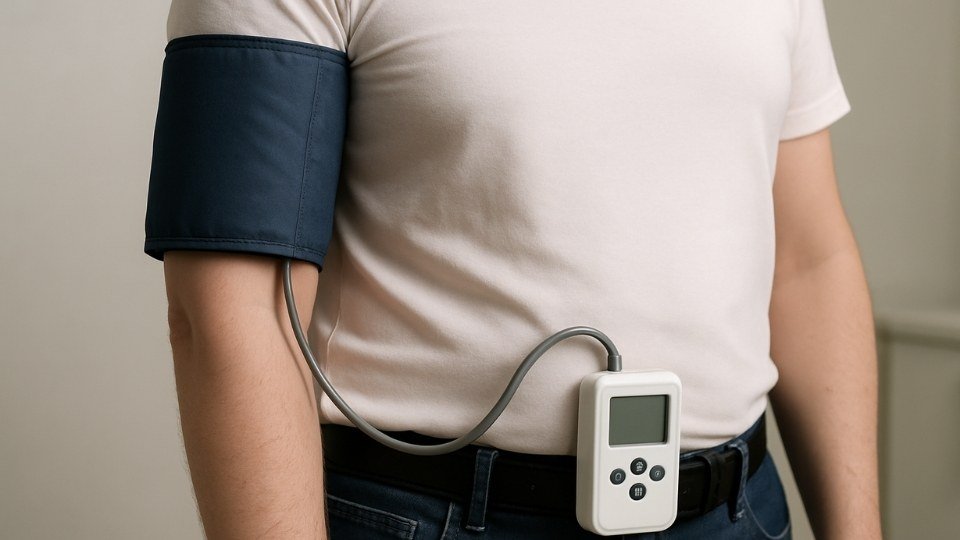The MAP blood pressure records more than 50 measurements throughout your day and night. With this data the cardiologist distinguishes between real, "white coat" or masked hypertension, and adjusts the treatment precisely. The study is performed at home: an automated cuff measures your blood pressure every 15-30 min and stores the values for analysis.
What is the blood pressure MAP and what is it for?
The MAP -in English ABPM- is a portable device that takes scheduled readings while you work, sleep or do light exercise. It allows:
- Detect pressure peaks linked to stress or activity.
- Check if your blood pressure descends at night (dipper pattern).
- Confirm or rule out white coat hypertension American Heart Association.
This information reduces the risk of over-medicating or leaving a dangerous pressure untreated.
Indications: When is a 24 h MAPA study needed?
- Elevated office readings with white coat suspicion.
- Treated patients whose pressure continues to fluctuate without apparent cause.
- Symptoms such as morning headachesporadic dizziness or blurred vision.
- Evaluation of hypertension in pregnancy.
- Control after drug adjustments or bariatric surgery.
The ACC/AHA 2023 guidelines recommend ABPM as the standard for confirming the diagnosis of hypertension before initiating pharmacological therapy.
Procedure: How is ambulatory monitoring performed?
- PlacementThe following features are available: non-dominant armband and cell phone sized recorder on a belt or shoulder strap.
- ProgrammingAutomatic inflation every 15 min during the day and 30-60 min at night.
- Normal lifeWork, sleep and walk carefully so as not to get the equipment wet.
- Activity diarynotes meals, exercise and symptoms to correlate with readings.
- Next day withdrawalThe software generates a trend report and averages.
Usual discomforts: nocturnal swelling that may awaken briefly and slight arm pressure.
Interpretation of results: normal and abnormal figures
| Period | Target (< 135/85 mmHg) | Hypertension si... |
|---|---|---|
| Daytime pressure | Average < 135/85 | ≥ 135/85 |
| Night pressure | Average < 120/70 | ≥ 120/70 |
| Circadian pattern | Descent 10-20 % at night | < 10 % ("non-dipper") |
A pattern non-dipper o elevated nocturnal pressure indicates increased risk of cardiovascular events and may require change of schedule or type of drug.
Benefits, advantages and risks of 24 h MAPA
Benefits
- More accurate diagnosis than isolated measurement.
- Individualized medication adjustment.
- It is a better predictor of infarction and stroke risk than office blood pressure.
Advantages over office pressure
| Feature | MAP | Spot measurement |
|---|---|---|
| Night readings | ✔️ | ❌ |
| White coat detection | ✔️ | Limited |
| Approximate cost PV | $1 800 MXN | - |
Risks minimal: mild skin irritation from the cuff or interrupted sleep.
Price and coverage: How much does a MAP cost in Puerto Vallarta?
The MAPA study price usually ranges from $1 700 and $2 000 MXNand includes placement, analysis software and interpreted report. Invoice is issued with CPT code; check with your insurance company for the reimbursement policy for ambulatory blood pressure monitoring.
Where to make a MAP 24 h in Puerto Vallarta?
Dr. Karla Castolo places the device in her office and provides detailed instructions. To ensure availability of the equipment, it is recommended to reserve a date in advance by phone or WhatsApp.
Next step for your MAP 24 h study
If your blood pressure numbers change or the treatment does not reach the goals, the 24 h MAP offers the most accurate measurement to customize your plan.
Request more information or schedule your MAPA study to really know how your blood pressure behaves day and night.
